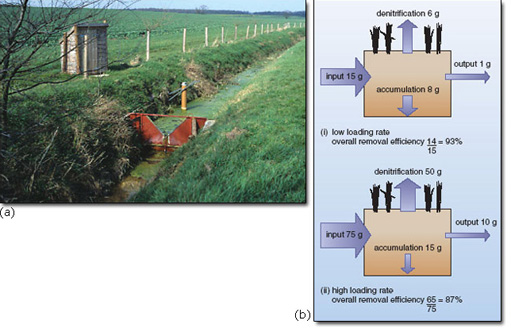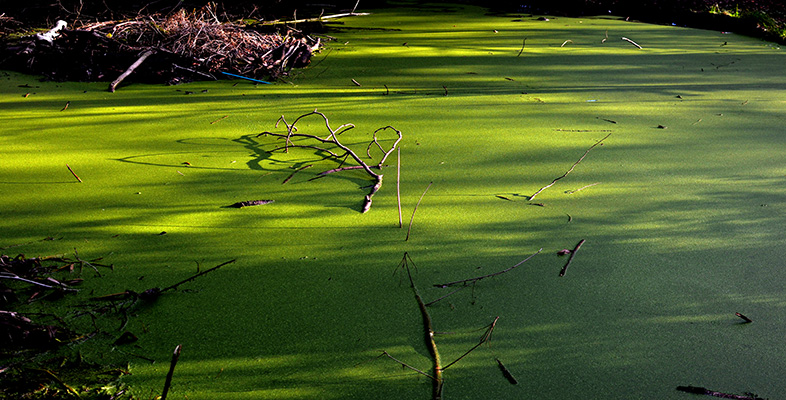4.4.3 Buffer strips
The interface between aquatic ecosystems and the land is an ecotone that has a profound influence on the movement of water and water-borne contaminants. Vegetation adjacent to streams and water bodies can help to safeguard water quality, particularly in agricultural landscapes. Buffer strips are used to reduce the amounts of nutrients reaching water bodies from runoff or leaching. They usually take the form of vegetated strips of land alongside water bodies: grassland, woodland and wetlands have been shown to be effective in different situations. The vegetation often performs a dual role, by reducing nutrient inputs to aquatic habitat and also providing wildlife habitat. A riparian buffer zone of between 20 and 30 m width can remove up to 100% of incoming nitrate. The plants take up nitrogen directly, provide a source of carbon for denitrifying bacteria and also create oxidized rhizospheres where denitrification can occur. Uptake of nitrogen by vegetation is often seasonal and is usually greater in forested areas with sub-surface water flow than in grassland with predominantly surface flow. The balance between surface flow and sub-surface flow, and the redox conditions that result, are critical in determining rates of nitrate removal in buffer strips (Figure 4.4).

The dynamics of nitrogen and phosphorus retention by soil and vegetation can alter during succession. In newly constructed wetlands, nitrogen retention commences as soon as emergent vegetation becomes established and soil organic matter starts to accumulate: usually within the first 1-3 years. Accumulation of organic carbon in the soil sets the stage for denitrification. After approximately 5-10 years, denitrification removes approximately the same amount of nitrogen as accumulates in organic matter (about 5-10 gm−2 yr−1 under conditions of low nitrogen loading). Under higher nitrogen loading, the amount of nitrogen stored in accumulating organic matter may double, and nitrogen removal by denitrification may increase by an order of magnitude or more. Accumulation of organic nitrogen and denitrification can therefore provide for reliable long-term removal of nitrogen regardless of nitrogen loading.
Phosphorus removal, on the other hand, tends to be greater during the first 1-3 years of succession when sediment deposition and sorption (absorption and adsorption) and precipitation of phosphorus are greatest. During the early stages of succession, wetlands may retain from 3 g P m−2 yr−1 under low phosphorus loadings, and as much as 30 g P m−2 yr−1 under high loadings. However, as sedimentation decreases and sorption sites become saturated, further phosphorus retention relies upon either its accumulation as organic phosphate in plants and their litter, or the precipitation with incoming aqueous and particulate cations such as iron, aluminium and calcium.
Nevertheless, in general, retention of phosphorus tends to be largely regulated by geochemical processes (sorption and precipitation) which operate independently of succession, whereas retention of nitrogen is more likely to be controlled by biological processes (e.g. organic matter accumulation, denitrification) that change in relative significance as succession proceeds.
Surface retention of sediment by vegetated buffer strips is a function of slope length and gradient, vegetation density and flow rates. Construction of effective buffer strips therefore requires detailed knowledge of an area’s hydrology and ecology. Overall, restoration of riparian zones in order to improve water quality may have greater economic benefits than allocation of the same land to cultivation of crops.
